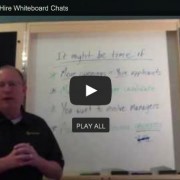Post-COVID Hiring: Job Candidate Motivations
Recently, I was fortunate to spend several days, in-person, at the HR Indiana SHRM conference in Indianapolis. Those three days consisted of learning, collaboration, communication of forecasts and trends, networking, and sharing of best practices in the human resources world. HR colleagues, I highly recommend attending your state SHRM chapter’s annual conference. It is enlightening, engaging and fun!
One of the overarching themes of the conference is that HR has changed since COVID evolved into a global pandemic. Throw supply chain deficits, cost-cutting, and increased employee vacancies into the mix, and that developed a storm that HR has had to weather together.
HR’s goals of finding and retaining essential talent, improving employee development, and fostering a collaborative, productive work environment has not changed. However, the methods through which HR professionals seek to attain those goals have changed dramatically.
As HR practitioners have witnessed, recruiting key talent has evolved. Job candidate motivations–their wants and needs–have changed, and candidates are leveraging those wants and needs as companies seek to fill numerous job openings from a tiny, ultra-competitive applicant pool.
Job Market Statistics
A few key stats before delving into a couple job candidate motivations that HR must evaluate to attract talent…
- In the US, an average of 4 million people per month have quit their jobs since January.
- In the US, almost 48 million employees quit their jobs last year.
Your Playbook for Activating Non-Traditional Talent Acquisition Channels, HR Indiana 2022
- About 10,000 Baby Boomers are turning 65 each day until 2030.
- There will be a shortfall of five million workers over the next few years.
- 40% of workers reported they are unlikely to stay with their organization post-COVID.
- 57% of Baby Boomers have shared less than half of their knowledge needed to perform their jobs when they retire.
-The Good, The Bad & The Ugly: HR Lessons Learned, HR Indiana 2022
Deep breath in. Deep breath out.
This blog post is not meant to scare or discourage HR professionals; it is meant as a proactive resource to help increase HR’s awareness of these ongoing and upcoming hurdles. Additionally, any HR team–from teams of 1 to 100+, can use this information to strategize and identify strengths that align with job candidate motivations. Then, with this alignment in place, hiring managers can more easily make the case that their company is the right company for top job candidates.
Job Candidate Motivations
What are job candidates’ wants, and in particular, needs? There is no “one-size-fits-all” compensation package for employees. This fact has become blatantly apparent since COVID cemented adaptability and flexibility as needs for both employers and employees.
- 95% employees want flexible hours.
- 78% employees seek location flexibility.
- 72% of workers reported they are likely to seek a new opportunity within the next year as a result of their employer’s current level of flexibility.
-The Good, The Bad & The Ugly: HR Lessons Learned, HR Indiana 2022
Tough crowd with unrealistic expectations? No, not really. COVID became the driver for employees of all levels to reevaluate their life, family and work responsibilities. Early retirements soared. COVID changed the way many industries and individuals’ roles were performed. Roles that were thought as necessary to be onsite were validated otherwise.
Remote Work and Flex Schedules
It did work for people to do their work at home. Of course, there are professions that are legitimately challenged to work full-time or part-time remote–such as teachers, mechanics, and healthcare practitioners to name a few. But overall, many roles and professions that were originally required to be onsite no longer must be onsite.
According to a Gartner survey, if a remote organization were to go back to a fully onsite arrangement, it would risk losing up to 39% of its workforce. Organizations cannot erase the past 2.5 years. Remote work increased, and many employees thrived personally and professionally with that option.
An organization must look into the mirror deeply and reflect on what remote and/or flex options they can offer employees at all levels that help with retention. Not all employees seek to work remotely, but multiple surveys show that the ability to be remote and/or flex is paramount to the majority. Here are a couple other items to consider as companies seek to reevaluate the employee value proposition.
Look at Internal Talent as a Candidate Source
Internal mobility is up 20% since the onset of COVID-19, according to LinkedIn data. This talent pool is readily accessible and often willing to explore new, challenging opportunities for internal growth. An organization’s HR department must start crafting plans to facilitate their employees’ mobility towards existing openings, leadership positions and newly created roles.
Encourage managers and employees to actively recommend teammates for internal openings. According to a Gartner survey, only 27% of active job seekers agree that their organization makes it easy for them to find job opportunities that suit their interests. Now, more than ever, employees must easily access internal openings and find opportunities that correlate to their skills.
Make Mental Health a Priority for Job Candidates
Many current employees are now feeling the negative effects of stress from attempting to balance personal and professional responsibilities during the pandemic. According to the World Health Organization, burnout is a syndrome resulting from workplace stress that has not been successfully managed. It is characterized by three dimensions: feelings of energy depletion or exhaustion, increased mental distance from one’s job or feelings of negativism or cynicism related to one’s job, and reduced professional efficacy (World Health Organization, 2019).
- $23 billion spent annually in the United States on work productivity loss due to depression.
- $16 trillion in loss output by 2030 due to mental illness.
- 200 million workdays are estimated annually due to depression.
-The Good, The Bad & The Ugly: HR Lessons Learned, HR Indiana 2022
Research is showing that the cost of implementing a workplace health and wellness system is significantly less than the cost of doing nothing to formally address and resolve workplace mental health issues. Loss of productivity and absenteeism will continue to rise if channels of assistance are not readily available to employees. And addressing mental health in the workplace cannot only improve employee morale and operations, it can attract new talent.
So HR should broadcast the details and goals of wellness programs to job candidates. In this way, the candidates understand the company’s commitment to physical and mental health without having to ask about it. Wellness programs are an investment in employees and should be rightfully included in employee branding. This will help an organization stand out among the competition and better align with important job candidate motivations.
HR Strength Post-COVID
In addition to change, a recurring theme at the HR Indiana SHRM conference was strength. Even in the midst of the chaos internally and externally, HR professionals will continue to rise to the challenge and overcome adversity successfully. Craft your plans and goals, then seek assistance to fulfill those goals from your support channels–resources in your senior and C-level management to help with funding, implementation and buy-in from your hourly workers who can voice support of new initiatives.
You can do this!
Photo by Thought Catalog on Unsplash









